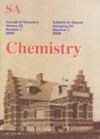Selective Solid-Phase Extraction Using Molecularly Imprinted Polymers for the Analysis of Target Pesticides in Cannabis Bud
IF 1
4区 化学
Q4 CHEMISTRY, MULTIDISCIPLINARY
South African Journal of Chemistry-Suid-Afrikaanse Tydskrif Vir Chemie
Pub Date : 2021-01-01
DOI:10.17159/0379-4350/2021/v75a17
引用次数: 0
Abstract
ABSTRACT A molecularly imprinted solid-phase extraction (MISPE) procedure was developed for the GC-MS analysis of four high priority pesticides (atrazine, terbuthylazine, acetochlor and alachlor) in a cannabis bud sample matrix. The study demonstrated that the synthesised polymer had a high affinity and good selectivity for either chloroacetamide or triazine classes of pesticide used as a template molecule during the molecularly imprinted polymerisation reaction. The MISPE procedure was optimised in terms of loading, washing and elution fractions utilising a range of aqueous methanol solutions for optimal recovery and minimal matrix interferences. The optimal wash fraction was 20% (v/v) methanol in an aqueous solution, whilst 70% (v/v) was used for the elution fraction. The selectivity, accuracy and recovery of the MISPEs were verified using a synthesised non-imprinted polymer and a commercial C18 cartridge as reference sorbents in comparative experiments. Approximately 3 g of the cannabis bud sample was spiked at a 0.05 mg/kg maximum residue limit (MRL) concentration. The recovery of the four selected pesticides extracted from the spiked samples ranged between 76.4-85.0% when utilising the optimised MISPE methods, compared to 91.6-96.9% for the C18 SPE. However, the use of the MISPE resulted in enhanced selectivity, as evidenced by GC-MS analysis, due to the extraction of less matrix interferences. Therefore, it can be concluded that the MISPE is a viable pre-treatment method for selective pesticide analysis in cannabis flowers using GC-MS when selectivity is valued for the extraction of target pesticides from a complex sample matrix. Keywords: molecularly imprinted polymer; solid-phase extraction; Cannabis; pesticides; atrazine; terbuthylazine; acetochlor; alachlor分子印迹聚合物选择性固相萃取法分析大麻芽中目标农药
建立了分子印迹固相萃取(MISPE)方法,用于分析大麻芽样品基质中4种高优先级农药(阿特拉津、特丁拉西嗪、乙草胺和甲草胺)的GC-MS分析。研究表明,所合成的聚合物在分子印迹聚合反应中对氯乙酰胺或三嗪类农药具有高亲和力和良好的选择性。MISPE程序在装载、洗涤和洗脱馏分方面进行了优化,使用一系列甲醇水溶液,以获得最佳回收率和最小的基质干扰。最佳洗涤分数为20% (v/v)甲醇水溶液,洗脱分数为70% (v/v)。在对比实验中,使用合成的非印迹聚合物和商用C18墨盒作为参考吸附剂,验证了MISPEs的选择性、准确性和回收率。约3克大麻芽样品以0.05 mg/kg最大残留限量(MRL)浓度加标。采用优化后的MISPE方法,4种农药的回收率为76.4 ~ 85.0%,而C18固相萃取法的回收率为91.6 ~ 96.9%。然而,正如GC-MS分析所证明的那样,由于提取较少的基质干扰,MISPE的使用提高了选择性。因此,当对复杂样品基质中目标农药的提取具有一定的选择性时,MISPE是一种可行的前处理方法。关键词:分子印迹聚合物;固相萃取;大麻;农药;阿特拉津;特丁津;乙草胺;草不绿
本文章由计算机程序翻译,如有差异,请以英文原文为准。
求助全文
约1分钟内获得全文
求助全文
来源期刊
CiteScore
3.10
自引率
0.00%
发文量
6
审稿时长
>12 weeks
期刊介绍:
Original work in all branches of chemistry is published in the South African Journal of Chemistry. Contributions in English may take the form of papers, short communications, or critical reviews.

 求助内容:
求助内容: 应助结果提醒方式:
应助结果提醒方式:


